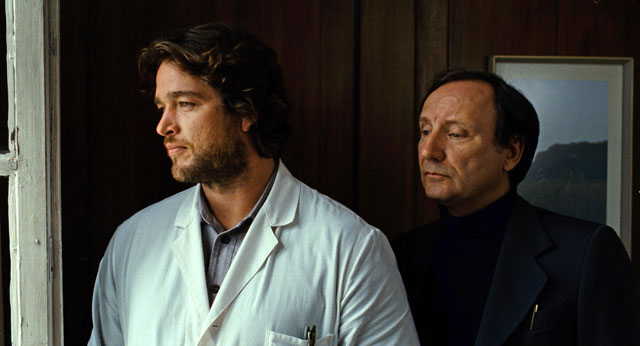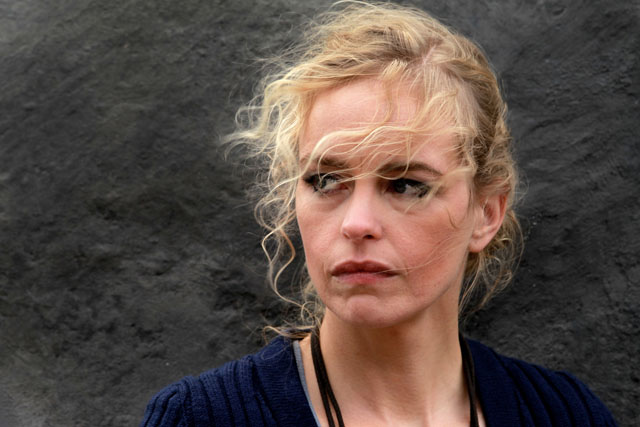Like Leos Carax’s Holy Motors, Christian Petzold‘s Barbara is slated to screen at the New York Film Festival in October and opens this weekend in the U.K. We’ll get to reviews from both engagements in a moment, but first let’s have a look at the batch that’s come out of Toronto.
“One of several films from this year’s Berlinale that were far more deserving of the Golden Bear than the actual winner, Barbara finds the normally austere Petzold shifting toward a more conventional, humanistically inclined art cinema,” writes Michael Sicinski for Cinema Scope. “His work certainly doesn’t suffer for this broadened accessibility, and it’s guaranteed to win new converts to his cause. But whereas Petzold’s recent films such as Yella (2007) and especially Jerichow (2008) examined the lingering impact of the GDR through the lens of post-communism’s displaced nomads, Barbara is a period piece, situating his benighted characters within the terror and malaise of the East German 1980s.”
“It may well be the best so far of all the German films made in recent years on the still very much contentious subject of the defunct German Democratic Republic (GDR),” writes Film International editor Daniel Lindvall. “Generally speaking, such films, at least the ones that have reached an international audience, tend to fall into two categories: those tinted by nostalgia (in German the term Ostalgie—combining the words for ‘east’ and ‘nostalgia’—is the label used for cultural expressions of nostalgia for the GDR) and those who, on the contrary, portray the GDR as a place of undiluted evil. Good Bye, Lenin! (2003) and The Lives of Others (2006) are probably the best-known examples of the respective category. Barbara treads a path beyond these ideological dead-end alleys.”
Barbara “stars the extraordinary Nina Hoss as a Berlin doctor who’s been banished to a rural hospital as punishment for requesting an exit visa,” explains Scott Tobias at the AV Club. “It’s an open secret among the country folk that Hoss is a possible subversive, and she doesn’t do much to try to fit into her new surroundings—her ‘otherness’ only begins to dissipate when she warms to the hospital’s chief physician (Ronald Zehrfeld), who she nonetheless can’t completely trust. The hostility directed toward Hoss is made subtly apparent: A few not-so-friendly visits to her assigned apartment, a flat tire on her bicycle after she returns from a tryst in the woods. But Petzold is careful to make those threats just a part of life in East Germany, more insinuating than explicit.”
“I didn’t find this film nearly as rich as the director’s last, Beats Being Dead, in the Dreileben triptych,” writes Notebook editor Daniel Kasman, “but its acute focus and especially its disturbingly casual, almost normative approach to making a period film (not stylistically similar to but philosophically like Michael Mann’s ahistorical historicity in Public Enemies) is sleek and haunting. The way it presents the heightened risk of living in the world at the same time it flattens the sense that this dangerous world is something in the past, far removed, is undoubtedly a very bold gesture.”
“Every other contemporary director of traditional narrative films would do well to study Petzold,” writes Darren Hughes. “From shot to shot, cut to cut, Barbara is smart, precise, classical filmmaking at its best.” Petzold’s style, adds Kenji Fujishima at the House Next Door, is “cool, precise, omniscient in its gaze. And yet it’s quite possible that he has never quite put that style to such appropriate and cumulatively devastating use.” On the other hand, David Fear in Time Out New York: “Admiration for the director’s sure hand won’t keep you… from feeling like this excavation of Germany’s political past may ultimately be a tad too remote for its own good.”
Petzold “generally frames [Barbara] in medium shot,” notes R. Emmet Sweeney at Movie Morlocks, “with Hoss placed in corners, her eyes slathered in mascara so they pop out of her pale face, looking with the same intensity as the doctors in the reproduction of Rembrandt’s The Anatomy Lesson of Dr. Nicolaes Tulip that hangs in Dr. Andre’s office. She is alert and pensive, scanning a mise-en-scene that is rebelling against her. Her apartment’s electrical outlets blow out, the doorbell sounds like a clattering death rattle (and usually portends worse), and her bike’s tires pop at regular intervals…. Nina Hoss presents Barbara as an imposing edifice, a stone-faced sphinx who speaks in brief bursts, transmitting as little information as possible. But her eyes tell the tale…”
John Semley for Slant: “Petzold’s comparably reserved style keeps things at arm’s length, as she scowls at her colleagues and slinks away to rendezvous with her West German paramour, Jörg (Mark Waschke), who makes pillow-talk about hatching her out of the bucolic penal colony. Things warm considerably when Barbara begins caring for Stella (Jasna Fritzi Bauer), a pregnant teenage runaway sick with meningitis…. The film’s authenticity may be attributable as much to Petzold’s steady directorial hand as his background: The director’s family fled the German Democratic Republic, giving him a connection to (and felt respect for) the material that marks him as something other than just a prying West German sneaking a peek over the wall.”
“Nina Hoss’s cold, edgy beauty begrudges easy sympathy,” writes Nigel Andrews in the Financial Times. “She wears her taut-boned looks like a Hitchcock blonde moving in on more serious nightmares…. The film is tensely watchable; I only wish, to reinvoke a master, there was more Hitchcock.”
“Though Barbara’s situation creates numerous opportunities for riffs on classic genre situations (in particular interrogation and chase sequences), Petzold resists sensationalizing his character’s mostly interior arc,” adds Glenn Heath Jr. at Little White Lies. “Barbara envisions a complex human situation left unfinished, still ripe with possibility and nuance.”
More from Peter Bradshaw (Guardian, 4/5), Robbie Collin (Telegraph, 3/5), and James Woodall (Arts Desk). And more on Christian Petzold and Barbara here in Keyframe: Dennis Harvey, just yesterday on Petzold’s position in current German cinema; and Kevin B. Lee‘s video essay, “Deceptive Surfaces and the Films of Christian Petzold.”
Updates, 9/30: “For Barbara, detachment is a mode of survival, for Petzold an aesthetic strategy,” writes Catherine Wheatley for Sight & Sound. “But by the film’s conclusion, it seems that both may have softened somewhat. Neither is worse off for it.”
“Petzold goes far beyond merely condemning a repressive regime,” writes Christopher Bourne at Twitch: “he gives us the inside view of how such a system twists the psyches of all who suffer under it, making people mistrust every aspect of human behavior, however seemingly benevolent and innocent on the surface.”
The Observer‘s Philip French finds that Barbara “is neither as well shaped nor as persuasive as The Lives of Others, with which it inevitably invites comparison, and there’s something overly contrived and melodramatic about the way Barbara’s options are set out. Nevertheless, this is a film of consequence.”
Update, 10/2: “Like the state, we are doing a kind of surveillance as spectators, piecing together the mystery of this character, her identity, just like her watchers,” writes Henry Stewart in the L. “Curiously, this puts us in an antagonistic position to our hero, especially for critics, who might feel, ahem, as though they’re just one more civilian informant filing a report.”
Update, 10/5: “Too often, to these eyes at least, Petzold’s precision seems merely neat, his ambiguities calculated, his ironies pat, his cleanliness sterile,” writes Andrew Trace in Reverse Shot. “If not quite the reductio ad absurdum of the contemporary international minimalist style, Petzold is at least a good argument for its potential limitations. If the Dardennes, to cite the paramount example, employ ellipsis and a radical economy of means to forge a revelatory way of looking at the world, Petzold—whose interests and ambitions, to be fair, do not necessarily lie in the same areas—crafts relatively sturdy fictions whose portentously unspoken implications scarcely resonate past the rolling of the closing credits. All that said, it’s not as if we are so rich in skillful cinematic craftsmen that we can simply write off one with such evident, effortless talent.”
Update, 10/7: Christina Gerhardt in the Brooklyn Rail: “Each of Petzold’s 11 features produced to date, including five made-for-television films, rests at the intersection of the main characters’ desire to belong or to have a home (or at the very least, not to be on the run) and the socio-political-economic conditions that thwart or stymie this desire—Heimat-building, or the creation of a home, as Petzold called it repeatedly in interviews he gave on the release of Jerichow (2008).”
Update, 10/16: Daniel Kasman and David Phelps have a wide-ranging chat with Christian Petzold: “We talked casually, launched by a mention of Henry James and Petzold’s love of Jack Clayton’s The Innocents, and segueing into the terrifying reveal in Petzold’s Dreileben film, Beats Being Dead. All the while we took in the roof’s unexpected and unusual view: Long Island City across the river, the Queensboro Bridge spanning the two islands, and, between the two, another, smaller presence, Roosevelt Island, terminated in the overgrown ruins of the Renwick Smallpox Hospital.”
NYFF 2012: a guide to the coverage of the coverage. For news and tips throughout the day every day, follow @KeyframeDaily on Twitter and/or the RSS feed. Get Keyframe Daily in your inbox by signing in at fandor.com/daily.





